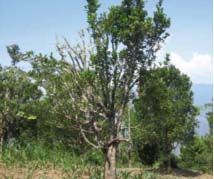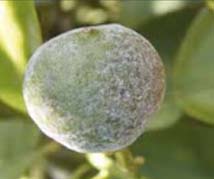What is Powdery Mildew?
It is fungal disease characterized by the presence of mildew on a plant marked by a white floury covering consisting of conidia. This disease appears at the start of summer months where there is dry season followed by rains and high humidity. With the onset of winter season, the disease starts receding.
Susceptibility – All citrus spp.
Causal organism– Oidium tingitaninum
Symptoms –
- Round white, cottony or powdery growth appears on the young twigs especially on the upper leaf surfaces.
- Infected leaves turn yellow and dry gradually.
- During severe infections, the leaves show pale and wrinkled distorted margins and falls prematurely
- Young shoots wither and die back.
- Affected fruits are covered with powdery growth and drop prematurely resulting in poor yield.
Reason of severity –
- Cool and moist condition are more prone to disease development.
- Too close plantation favors the disease development.
| A | B | C |
 |  |  |
| Tree die back caused by Powdery mildew | Symptoms on leaves | Symptoms on fruit |
Source-https://www.daf.qld.gov.au/__data/assets/pdf_file/0006/65166/Citrus-Citrus-powdery-mildew.pdf
Management-
| Cultural Practices | Biological Control | Chemical Control |
| Prune and destroy the infected parts of the plant.Proper sanitation of orchard should be carried out. | Application of Ampelomyces quisqualis @ 0.5% at fortnight interval during the emergence of new leaves. | Spray Sulphur 80% WP @ 2 g per liter Spray Carbendazim 50% WP @ 2g per literSpray Benomyl 50% WP @ 0.5g per liter water 3- 5 times at 15-20 days interval will help to control disease effectively.Dusting Sulphur 80% WP @ 10kg/acre in the morning hours helps to controls the disease effectively. |
Source –
Book – Handbook of Horticulture








